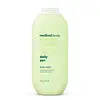What's inside
What's inside
 Key Ingredients
Key Ingredients

 Benefits
Benefits

 Concerns
Concerns

 Ingredients Side-by-side
Ingredients Side-by-side

Water
Skin ConditioningSodium Lauryl Sulfate
CleansingCocamidopropyl Betaine
CleansingParfum
MaskingCoco-Glucoside
CleansingGlyceryl Oleate
EmollientGlyceryl Stearate
EmollientGlycol Distearate
EmollientAmmonium Chloride
BufferingCitric Acid
BufferingGlycerin
HumectantLauryl Lactate
EmollientMethyl Glucose Caprate/Caprylate/Oleate
EmollientPolyglyceryl-3 Laurate
EmulsifyingPropanediol
SolventCamellia Sinensis Leaf Extract
AntimicrobialCucumis Sativus Fruit Extract
EmollientFucus Vesiculosus Extract
EmollientEthylhexylglycerin
Skin ConditioningMethylchloroisothiazolinone
PreservativeMethylisothiazolinone
PreservativePhenoxyethanol
PreservativeWater, Sodium Lauryl Sulfate, Cocamidopropyl Betaine, Parfum, Coco-Glucoside, Glyceryl Oleate, Glyceryl Stearate, Glycol Distearate, Ammonium Chloride, Citric Acid, Glycerin, Lauryl Lactate, Methyl Glucose Caprate/Caprylate/Oleate, Polyglyceryl-3 Laurate, Propanediol, Camellia Sinensis Leaf Extract, Cucumis Sativus Fruit Extract, Fucus Vesiculosus Extract, Ethylhexylglycerin, Methylchloroisothiazolinone, Methylisothiazolinone, Phenoxyethanol
Water
Skin ConditioningSodium Lauroyl Sarcosinate
CleansingLauryl Glucoside
CleansingHydroxyethylcellulose
Emulsion StabilisingCitrus Aurantium Dulcis Peel Oil
MaskingCitrus Paradisi Peel Oil
MaskingPelargonium Graveolens Flower Oil
MaskingCitrus Aurantifolia Oil
CleansingRosa Damascena Flower Oil
MaskingPogostemon Cablin Leaf Oil
MaskingCananga Odorata Flower Oil
MaskingSimmondsia Chinensis Seed Oil
EmollientRosa Canina Fruit Oil
EmollientMelaleuca Alternifolia Leaf Oil
AntioxidantMacadamia Integrifolia Seed Oil
Skin ConditioningAlcohol
AntimicrobialXanthan Gum
EmulsifyingChamomilla Recutita Flower Extract
MaskingPolysorbate 60
EmulsifyingDisodium Phosphate
BufferingSodium Phosphate
BufferingLimonene
PerfumingCitronellol
PerfumingCitric Acid
BufferingPhenoxyethanol
PreservativeBenzyl Alcohol
PerfumingPotassium Sorbate
PreservativeLinalool
PerfumingGeraniol
PerfumingWater, Sodium Lauroyl Sarcosinate, Lauryl Glucoside, Hydroxyethylcellulose, Citrus Aurantium Dulcis Peel Oil, Citrus Paradisi Peel Oil, Pelargonium Graveolens Flower Oil, Citrus Aurantifolia Oil, Rosa Damascena Flower Oil, Pogostemon Cablin Leaf Oil, Cananga Odorata Flower Oil, Simmondsia Chinensis Seed Oil, Rosa Canina Fruit Oil, Melaleuca Alternifolia Leaf Oil, Macadamia Integrifolia Seed Oil, Alcohol, Xanthan Gum, Chamomilla Recutita Flower Extract, Polysorbate 60, Disodium Phosphate, Sodium Phosphate, Limonene, Citronellol, Citric Acid, Phenoxyethanol, Benzyl Alcohol, Potassium Sorbate, Linalool, Geraniol
 Reviews
Reviews

Ingredients Explained
These ingredients are found in both products.
Ingredients higher up in an ingredient list are typically present in a larger amount.
Citric Acid is an alpha hydroxy acid (AHA) naturally found in citrus fruits like oranges, lemons, and limes.
Like other AHAs, citric acid can exfoliate skin by breaking down the bonds that hold dead skin cells together. This helps reveal smoother and brighter skin underneath.
However, this exfoliating effect only happens at high concentrations (20%) which can be hard to find in cosmetic products.
Due to this, citric acid is usually included in small amounts as a pH adjuster. This helps keep products slightly more acidic and compatible with skin's natural pH.
In skincare formulas, citric acid can:
While it can provide some skin benefits, research shows lactic acid and glycolic acid are generally more effective and less irritating exfoliants.
Most citric acid used in skincare today is made by fermenting sugars (usually from molasses). This synthetic version is identical to the natural citrus form but easier to stabilize and use in formulations.
Read more about some other popular AHA's here:
Learn more about Citric AcidPhenoxyethanol is a preservative that has germicide, antimicrobial, and aromatic properties. Studies show that phenoxyethanol can prevent microbial growth. By itself, it has a scent that is similar to that of a rose.
It's often used in formulations along with Caprylyl Glycol to preserve the shelf life of products.
Water. It's the most common cosmetic ingredient of all. You'll usually see it at the top of ingredient lists, meaning that it makes up the largest part of the product.
So why is it so popular? Water most often acts as a solvent - this means that it helps dissolve other ingredients into the formulation.
You'll also recognize water as that liquid we all need to stay alive. If you see this, drink a glass of water. Stay hydrated!
Learn more about Water